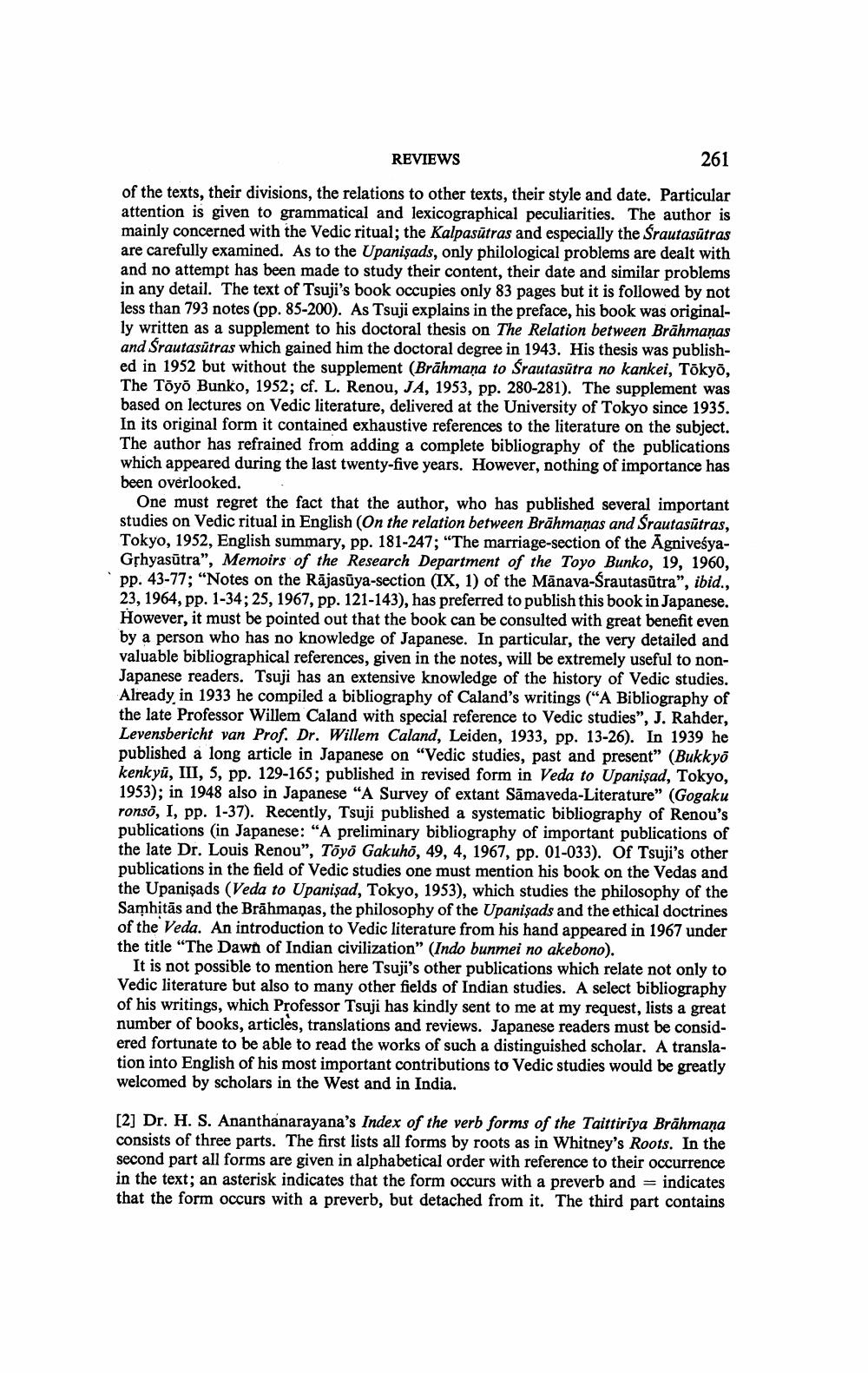________________ REVIEWS 261 of the texts, their divisions, the relations to other texts, their style and date. Particular attention is given to grammatical and lexicographical peculiarities. The author is mainly concerned with the Vedic ritual; the Kalpasutras and especially the Srautasutras are carefully examined. As to the Upanisads, only philological problems are dealt with and no attempt has been made to study their content, their date and similar problems in any detail. The text of Tsuji's book occupies only 83 pages but it is followed by not less than 793 notes (pp. 85-200). As Tsuji explains in the preface, his book was originally written as a supplement to his doctoral thesis on The Relation between Brahmanas and Srautasutras which gained him the doctoral degree in 1943. His thesis was published in 1952 but without the supplement (Brahmana to Srautasutra no kankei, Tokyo, The Toyo Bunko, 1952; cf. L. Renou, JA, 1953, pp. 280-281). The supplement was based on lectures on Vedic literature, delivered at the University of Tokyo since 1935. In its original form it contained exhaustive references to the literature on the subject. The author has refrained from adding a complete bibliography of the publications which appeared during the last twenty-five years. However, nothing of importance has been overlooked. One must regret the fact that the author, who has published several important studies on Vedic ritual in English (On the relation between Brahmanas and Srautasutras, Tokyo, 1952, English summary, pp. 181-247; "The marriage-section of the AgnivesyaGshyasutra", Memoirs of the Research Department of the Toyo Bunko, 19, 1960, pp. 43-77; "Notes on the Rajasuya-section (IX, 1) of the Manava-Srautasutra", ibid., 23, 1964, pp. 1-34; 25, 1967, pp. 121-143), has preferred to publish this book in Japanese. However, it must be pointed out that the book can be consulted with great benefit even by a person who has no knowledge of Japanese. In particular, the very detailed and valuable bibliographical references, given in the notes, will be extremely useful to nonJapanese readers. Tsuji has an extensive knowledge of the history of Vedic studies. Already in 193 he compiled a bibliography of Caland's writings ("A Bibliography of the late Professor Willem Caland with special reference to Vedic studies", J. Rahder, Levensbericht van Prof. Dr. Willem Caland, Leiden, 1933, pp. 13-26). In 1939 he published a long article in Japanese on "Vedic studies, past and present" (Bukkyo kenkyu, III, 5, pp. 129-165; published in revised form in Veda to Upanisad, Tokyo, 1953); in 1948 also in Japanese "A Survey of extant Samaveda-Literature" (Gogaku ronso, I, pp. 1-37). Recently, Tsuji published a systematic bibliography of Renou's publications in Japanese: "A preliminary bibliography of important publications of the late Dr. Louis Renou", Toyo Gakuho, 49, 4, 1967, pp. 01-033). Of Tsuji's other publications in the field of Vedic studies one must mention his book on the Vedas and the Upanisads (Veda to Upanisad, Tokyo, 1953), which studies the philosophy of the Samhitas and the Brahmanas, the philosophy of the Upanisads and the ethical doctrines of the Veda. An introduction to Vedic literature from his hand appeared in 1967 under the title "The Dawn of Indian civilization" (Indo bunmei no akebono). It is not possible to mention here Tsuji's other publications which relate not only to Vedic literature but also to many other fields of Indian studies. A select bibliography of his writings, which Professor Tsuji has kindly sent to me at my request, lists a great number of books, articles, translations and reviews. Japanese readers must be considered fortunate to be able to read the works of such a distinguished scholar. A translation into English of his most important contributions to Vedic studies would be greatly welcomed by scholars in the West and in India. [2] Dr. H. S. Ananthanarayana's Index of the verb forms of the Taittiriya Brahmana consists of three parts. The first lists all forms by roots as in Whitney's Roots. In the second part all forms are given in alphabetical order with reference to their occurrence in the text; an asterisk indicates that the form occurs with a preverb and = indicates that the form occurs with a preverb, but detached from it. The third part contains




